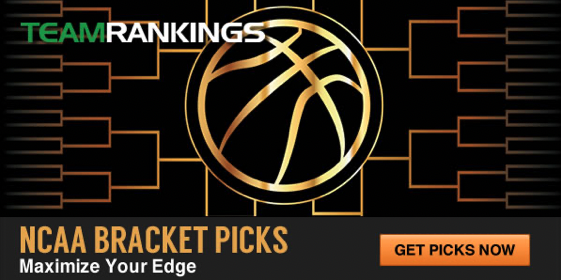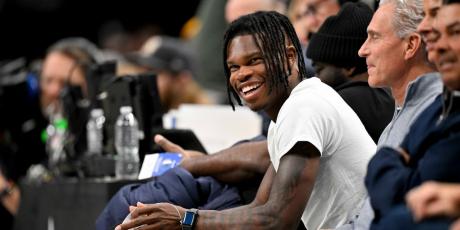Bracket Pick Strategy: To Win Your NCAA Pool, Don't Try To Make Perfect Picks

This is a guest post by TeamRankings.com—a site that has helped subscribers win more than $1.75 million in bracket pool prizes with their NCAA Bracket Picks.
The French philosopher Voltaire is often credited with the phrase, “perfect is the enemy of the good.” Those playing in bracket contests this March would be wise to heed that advice.
A lot of people strive for perfection with their bracket strategy. Everyone knows there will be some upsets and Cinderella stories that happen, and plenty of bracket pool players hope to achieve fame and fortune by predicting those improbable outcomes.
How has that strategy been going? For starters, multiple online contest sites have offered millions of dollars in prize money for picking a perfect bracket. Yet so far, no one has retired and bought a private island based on correctly forecasting every improbable event in the NCAA Tournament.
The NCAA has tracked “perfect brackets” for years, and across 20 million or more submitted brackets each year, the farthest into the tournament that a bracket made it undefeated was 49 wins in 2019, perfect through two rounds.
That entry, we should note, got only six more wins in the final 14 games, and had neither team that played in the championship game. So what looked like a historically great bracket through two rounds probably wouldn’t even have claimed any prize money in a relatively small pool among a group of friends.
The Picks That Win Bracket Pools
At TeamRankings, we’ve studied bracket contests for over 20 years. We’ve built technology to simulate the NCAA tournament millions of times, and we’ve measured the performance of billions of different brackets in hypothetical pools.
All this research has led to a precise understanding of what it takes to win a bracket pool. And the pick strategies that win March Madness pools most often do not match the perception of how many people think they should pick a bracket.
Mid-Sized Pool Pick Examples
To give a specific example, one of our team members plays in a bracket pool in the 100-200 entry range (a larger pool than average, but not huge) that has been running for over 20 years. Only about once per decade has even one bracket in the pool picked all four Final Four teams correctly. Yet every year, one player still walks away with a nice chunk of change for winning.
The winner most years is usually somebody who makes solid picks through the first few rounds, gets two or three Final Four teams correct, and/or nails their NCAA champion pick. But in some years, when a very unpopular pick wins the tournament, nobody in the pool—including the winner—has gotten their champion pick right.
Another one of us played in a pool with over 300 entries last year. Guess how many brackets that eventually won prizes correctly picked No. 11 seed UCLA to the Final Four? Zero.
In fact, none of the prize-winning entries in this 300-person pool picked a team that was seeded lower than fourth in their Final Four. All of the brackets that won smaller prizes would have fared better if they had not taken some risky swings on double-digit seeds to reach the Sweet Sixteen.
TeamRankings.com: Get the best bracket for your pool »
Concentrating Bracket Pick Risk
Those types of results demonstrate why it often makes sense to pick conservatively across most of the bracket and concentrate your risk on one or two educated bets where it matters most: The later rounds.
The smaller your pool, the more that strategy applies. If you are in a pool of fewer than 10 people, for instance, simply going with mostly "chalk" picks (favorites) in the early rounds typically works just fine. Several opponents will shoot themselves in the foot trying to nail a lot of improbable upsets, falling by the wayside.
In a very large pool, all bets are off, because there are enough entries that a handful of them will get lucky and pick the big upsets that actually happen. So you have to dial up the risk profile of your own bracket accordingly, to have a chance to beat them.
Still, most people don't realize that even picking top teams can create differentiation. Imagine you pick two No. 1 seeds, or maybe a No. 1 seed and the strongest No. 2 seed, to meet in the final game. Even if both of those teams are reasonably popular finalist picks, only around 5-10% of the entries in your pool would be expected to have the exact same combination of NCAA champion and runner-up as you do.
That’s why even in a 100-entry pool, you can still pick mostly conservatively and give yourself a better chance to win than anyone else. It may only take one or two high-leverage bets on contrarian picks, like taking an unpopular but strong No. 6 seed to advance to the Final Four, instead of a popular but relatively weak No. 3 seed.
The Best Bracket In 2022
The general advice we give in this article applies to most traditional bracket pools that use the 1-2-4-8-16-32 scoring system, at small-to-moderate pool sizes. Every pool and every NCAA tournament is different, though.
How you pick a bracket if it awards bonus points for correctly picking upsets—especially in 2022 when the teams on the No. 6 through No. 11 seed lines are closer in quality than they usually are—is a completely different story. Even in a traditional bracket pool, you still need to know which higher seeds are the best risks to take because you can only pick two of them to make the final game.
That's why we built the world's first bracket optimizer. You tell it a few details about your pool, and in seconds, it generates a ready-to-play bracket that gives you the best chance to win. It's all based on technology so sophisticated WIRED Magazine wrote about it.
The result? Every year, an average of 57% of our subscribers have reported winning a bracket pool prize.
In addition to customized bracket picks, our product offers all the predictions, tools, and data you need to maximize your edge in all sorts of March Madness pools (including NCAA survivor pools and Calcutta auctions) and even NCAA tournament futures bets.















